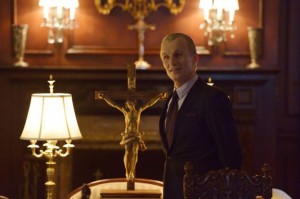 I’m a little behind on watching episodes of The Strain, but one which aired a couple of weeks ago caught my attention because of the conflicting ways in which it portrayed Christianity. Previously I’ve commented on the way the series engages the Christian faith, particularly in its Roman Catholic expression. This is due to Guillermo del Toro’s negative experiences with Catholicism when growing up with a devout and stern Catholic grandmother. Although del Toro considers himself an agnostic, he also identifies in some ways as a lapsed Catholic. So it is no surprise that the religious tension in del Toro’s own life surfaces in his artistic expression as co-author of The Strain series of books, producer of the series, and director of a few episodes.
I’m a little behind on watching episodes of The Strain, but one which aired a couple of weeks ago caught my attention because of the conflicting ways in which it portrayed Christianity. Previously I’ve commented on the way the series engages the Christian faith, particularly in its Roman Catholic expression. This is due to Guillermo del Toro’s negative experiences with Catholicism when growing up with a devout and stern Catholic grandmother. Although del Toro considers himself an agnostic, he also identifies in some ways as a lapsed Catholic. So it is no surprise that the religious tension in del Toro’s own life surfaces in his artistic expression as co-author of The Strain series of books, producer of the series, and director of a few episodes.
In the episode a couple of weeks ago, Thomas Eichhorst, a vampire who serves The Master, seeks an ancient book, the Occido Lumen, rumored to contain ways in which to defeat this vampiric evil. The book is in the possession of a Catholic Cardinal, apparently corrupted by his power and money. Eichhorst confronts the Cardinal to take possession of the Occido Lumen, and pauses to comment as he looks at a large crucifix. His hands run up and down it, and he says that it seems like a strange way to treat your only son, referring to the humiliating death by crucifixion of Jesus represented in the crucifix. This is intended as mockery of a key tenet not only of Catholicism, but also of historic Christendom. Yet at the same time it raises interesting theological questions about the Christian doctrine of the atonement that are debated by contemporary theologians. Eichhorst attacks the Catholic Cardinal and infects him with the worms that lead to vampirism so that his knowledge of the location of the book will become known to The Master. Before he is attacked the Bishop is pictured on his knees looking upward to heaven praying for deliverance. Eichhorst looks up mirroring the Bishop’s gaze and asks where this would-be divine deliverer is and why he doesn’t rescue his follower. No, he says, The Master will soon demonstrate that he is the true Lord to be followed.
But while these two elements represent a mockery and subversion of Catholic and Christian belief, the scene changes not long after. Abraham Setrakian, who is also looking for the book, chases off Eichhorst, and offers to cleanse the soul of the Bishop by releasing him of the vampiric infection through death by beheading. Here Setrakian becomes the counterpoint to the mockery of the previous scenes and embodies faith in Christianity as a force for good with the power to overcome the evil of the infectious vampiric strain.
It will be interesting to watch how the religious tensions of The Strain continue to manifest themselves, many of the same kinds of tensions found not only in Guillermo del Toro, but also many in Western culture as well.





One Response to “Religious tensions expressed again in The Strain”